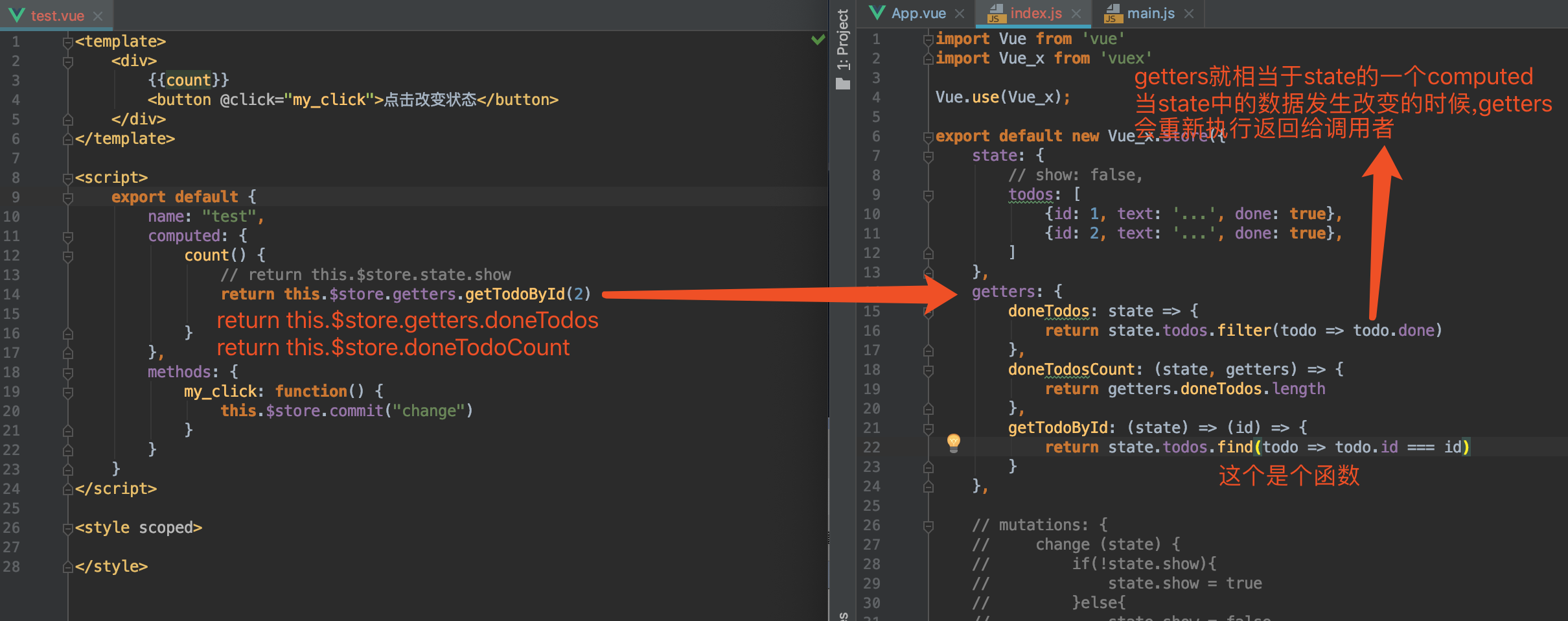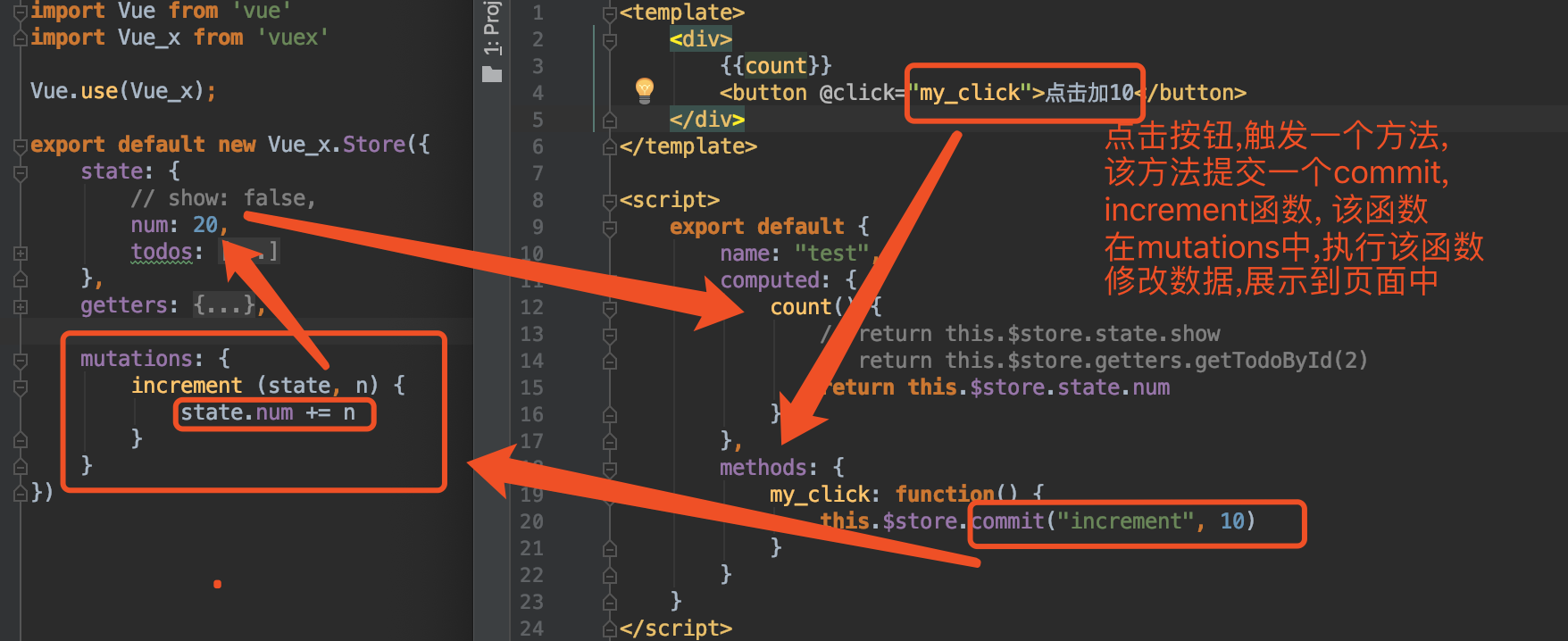每一个 Vuex 应用的核心就是 store(仓库)。“store”基本上就是一个容器,它包含着你的应用中大部分的状态 (state)。Vuex 和单纯的全局对象有以下两点不同:
-
Vuex 的状态存储是响应式的。当 Vue 组件从 store 中读取状态的时候,若 store 中的状态发生变化,那么相应的组件也会相应地得到高效更新。
-
你不能直接改变 store 中的状态。改变 store 中的状态的唯一途径就是显式地提交 (commit) mutation。这样使得我们可以方便地跟踪每一个状态的变化,从而让我们能够实现一些工具帮助我们更好地了解我们的应用。
最简单的Store
// 如果在模块化构建系统中,请确保在开头调用了 Vue.use(Vuex) const store = new Vuex.Store({ state: { count: 0 }, mutations: { increment (state) { state.count++ } } })
现在,你可以通过 store.state 来获取状态对象,以及通过 store.commit 方法触发状态变更:
store.commit('increment')
console.log(store.state.count) // -> 1
注意: 通过提交mutation的方式,而非直接改变store.state.count.
注册store, 调用Vue.use(Vuex)
const app = new Vue({ el: '#app', // 把 store 对象提供给 “store” 选项,这可以把 store 的实例注入所有的子组件 store, components: { Counter }, template: ` <div class="app"> <counter></counter> </div> ` })
之后我们就可以通过this.$store访问.
const Counter = { template: `<div>{{ count }}</div>`, computed: { count () { return this.$store.state.count } } }
Getter

(此时不理解mapGetters,和mapState)
Mutation
更改 Vuex 的 store 中的状态的唯一方法是提交 mutation。Vuex 中的 mutation 非常类似于事件:每个 mutation 都有一个字符串的 事件类型 (type) 和 一个 回调函数 (handler)。这个回调函数就是我们实际进行状态更改的地方,并且它会接受 state 作为第一个参数:
const store = new Vuex.Store({ state: { count: 1 }, mutations: { increment (state) { // 变更状态 state.count++ } } })
不能直接调用一个mutation handler.这个选项更像是事件注册: "当触发一个类型为increment的mutation时", 调用此函数." 要唤醒一个mutationhandler,你需要已相应的type调用storecommit方法;
store.commit('increment')
也可以向store.commit传入额外的参数,即mutation的载荷(payload)

大多数情况下,载荷应该是一个对象,这样可以包含多个字段并且记录的mutation会更容易读
// ... mutations: { increment (state, payload) { state.count += payload.amount } }
store.commit('increment', {
amount: 10
})
提交mutation的的另一种方式是直接使用包含type属性的对象;
store.commit({ type: 'increment', amount: 10 })
整个对象都作为载荷传给 mutation 函数. 因此 handler 保持不变:
mutations: { increment (state, payload) { state.count += payload.amount } }
Mutation需要遵循Vue的响应规则
1, 最好提前在你的store中初始化号所有的所需属性
2, 当需要在对象上添加新属性时,应该
Vue.set(obj, 'newProp', 123)
或者以新对象替换老对象
使用常量替代Mutation事件类型(可用可不用,只是一种代码风格,对于大型项目会很有用)
// mutation-types.js export const SOME_MUTATION = 'SOME_MUTATION'
// store.js import Vuex from 'vuex' import { SOME_MUTATION } from './mutation-type' const store = new Vuex.Store({ state: {...} mutation: { [SOME_MUTATION] (state){ // mutate state }}})
在组件中提交Mutation
你可以在组件中使用 this.$store.commit('xxx') 提交 mutation,或者使用 mapMutations 辅助函数将组件中的 methods 映射为 store.commit 调用(需要在根节点注入 store)。
import { mapMutations } from 'vuex'
export default {
// ...
methods: {
...mapMutations([
'increment', // 将 `this.increment()` 映射为 `this.$store.commit('increment')`
// `mapMutations` 也支持载荷:
'incrementBy' // 将 `this.incrementBy(amount)` 映射为 `this.$store.commit('incrementBy', amount)`
]),
...mapMutations({
add: 'increment' // 将 `this.add()` 映射为 `this.$store.commit('increment')`
})
}
}
在mutation中混合调用会导致程序很难调试,例如,当你调用了两个包含异步回调的 mutation 来改变状态,你怎么知道什么时候回调和哪个先回调呢?这就是为什么我们要区分这两个概念。在 Vuex 中,mutation 都是同步事务:
store.commit('increment')
// 任何由 "increment" 导致的状态变更都应该在此刻完成。
Action 处理异步操作
Action类似于mutation,不同在于:
Action提交的是mutation,而不是直接更改状态
Action可以包含任意异步操作
注册一个简单的action
const store = new Vuex.Store({ state: { count: 0 }, mutations: { increment (state) { state.count++ } }, actions: { increment (context) { context.commit('increment') } } })
Action函数接受一个与store实例具有相同方法和属性的context对象,因此你可以调用context.commit提交一个mutation,或者通过context.state和context.getters来获取state和getters
分发Action
Action通过store.dispatch方法触发:
store.dispatch('increment')
// 以载荷形式分发 store.dispatch('incrementAsync', {amount: 10}) // 以对象形式分发 store.dispatch({type: 'incrementAsync', amount: 10})
Module
使用单一状态树,
应用的所有状态会集中到一个比较大的对象。当应用变得非常复杂时,store 对象就有可能变得相当臃肿。
为了解决以上问题,Vuex 允许我们将 store 分割成模块(module)。每个模块拥有自己的 state、mutation、action、getter、甚至是嵌套子模块——从上至下进行同样方式的分割:
const moduleA = { state: { ... }, mutations: { ... }, actions: { ... }, getters: { ... } } const moduleB = { state: { ... }, mutations: { ... }, actions: { ... } } const store = new Vuex.Store({ modules: { a: moduleA, b: moduleB } }) store.state.a // -> moduleA 的状态 store.state.b // -> moduleB 的状态
axios笔记
// 为给定 ID 的 user 创建请求 axios.get('/user?ID=12345') .then(function (response) { console.log(response); }) .catch(function (error) { console.log(error); }); // 可选地,上面的请求可以这样做 axios.get('/user', { params: { ID: 12345 } }) .then(function (response) { console.log(response); }) .catch(function (error) { console.log(error); });
执行多个并发请求
function getUserAccount() { return axios.get('/user/12345'); } function getUserPermissions() { return axios.get('/user/12345/permissions'); } axios.all([getUserAccount(), getUserPermissions()]) .then(axios.spread(function (acct, perms) { // 两个请求现在都执行完成 }));
axios API
// 发送 POST 请求 axios({ method: 'post', url: '/user/12345', data: { firstName: 'Fred', lastName: 'Flintstone' } });
请求方法的别名
axios.request(config)
axios.get(url[, config])
axios.delete(url[, config])
axios.head(url[, config])
axios.post(url[, data[, config]])
axios.put(url[, data[, config]])
axios.patch(url[, data[, config]])
并发:
axios.all(iterable)
axios.spread(callback)
创建实例
axios.crate([config])
var instance = axios.create({ baseURL: 'http:...', timeout: 1000, headers: {} })

{ // `url` 是用于请求的服务器 URL url: '/user', // `method` 是创建请求时使用的方法 method: 'get', // 默认是 get // `baseURL` 将自动加在 `url` 前面,除非 `url` 是一个绝对 URL。 // 它可以通过设置一个 `baseURL` 便于为 axios 实例的方法传递相对 URL baseURL: 'https://some-domain.com/api/', // `transformRequest` 允许在向服务器发送前,修改请求数据 // 只能用在 'PUT', 'POST' 和 'PATCH' 这几个请求方法 // 后面数组中的函数必须返回一个字符串,或 ArrayBuffer,或 Stream transformRequest: [function (data) { // 对 data 进行任意转换处理 return data; }], // `transformResponse` 在传递给 then/catch 前,允许修改响应数据 transformResponse: [function (data) { // 对 data 进行任意转换处理 return data; }], // `headers` 是即将被发送的自定义请求头 headers: {'X-Requested-With': 'XMLHttpRequest'}, // `params` 是即将与请求一起发送的 URL 参数 // 必须是一个无格式对象(plain object)或 URLSearchParams 对象 params: { ID: 12345 }, // `paramsSerializer` 是一个负责 `params` 序列化的函数 // (e.g. https://www.npmjs.com/package/qs, http://api.jquery.com/jquery.param/) paramsSerializer: function(params) { return Qs.stringify(params, {arrayFormat: 'brackets'}) }, // `data` 是作为请求主体被发送的数据 // 只适用于这些请求方法 'PUT', 'POST', 和 'PATCH' // 在没有设置 `transformRequest` 时,必须是以下类型之一: // - string, plain object, ArrayBuffer, ArrayBufferView, URLSearchParams // - 浏览器专属:FormData, File, Blob // - Node 专属: Stream data: { firstName: 'Fred' }, // `timeout` 指定请求超时的毫秒数(0 表示无超时时间) // 如果请求话费了超过 `timeout` 的时间,请求将被中断 timeout: 1000, // `withCredentials` 表示跨域请求时是否需要使用凭证 withCredentials: false, // 默认的 // `adapter` 允许自定义处理请求,以使测试更轻松 // 返回一个 promise 并应用一个有效的响应 (查阅 [response docs](#response-api)). adapter: function (config) { /* ... */ }, // `auth` 表示应该使用 HTTP 基础验证,并提供凭据 // 这将设置一个 `Authorization` 头,覆写掉现有的任意使用 `headers` 设置的自定义 `Authorization`头 auth: { username: 'janedoe', password: 's00pers3cret' }, // `responseType` 表示服务器响应的数据类型,可以是 'arraybuffer', 'blob', 'document', 'json', 'text', 'stream' responseType: 'json', // 默认的 // `xsrfCookieName` 是用作 xsrf token 的值的cookie的名称 xsrfCookieName: 'XSRF-TOKEN', // default // `xsrfHeaderName` 是承载 xsrf token 的值的 HTTP 头的名称 xsrfHeaderName: 'X-XSRF-TOKEN', // 默认的 // `onUploadProgress` 允许为上传处理进度事件 onUploadProgress: function (progressEvent) { // 对原生进度事件的处理 }, // `onDownloadProgress` 允许为下载处理进度事件 onDownloadProgress: function (progressEvent) { // 对原生进度事件的处理 }, // `maxContentLength` 定义允许的响应内容的最大尺寸 maxContentLength: 2000, // `validateStatus` 定义对于给定的HTTP 响应状态码是 resolve 或 reject promise 。如果 `validateStatus` 返回 `true` (或者设置为 `null` 或 `undefined`),promise 将被 resolve; 否则,promise 将被 rejecte validateStatus: function (status) { return status >= 200 && status < 300; // 默认的 }, // `maxRedirects` 定义在 node.js 中 follow 的最大重定向数目 // 如果设置为0,将不会 follow 任何重定向 maxRedirects: 5, // 默认的 // `httpAgent` 和 `httpsAgent` 分别在 node.js 中用于定义在执行 http 和 https 时使用的自定义代理。允许像这样配置选项: // `keepAlive` 默认没有启用 httpAgent: new http.Agent({ keepAlive: true }), httpsAgent: new https.Agent({ keepAlive: true }), // 'proxy' 定义代理服务器的主机名称和端口 // `auth` 表示 HTTP 基础验证应当用于连接代理,并提供凭据 // 这将会设置一个 `Proxy-Authorization` 头,覆写掉已有的通过使用 `header` 设置的自定义 `Proxy-Authorization` 头。 proxy: { host: '127.0.0.1', port: 9000, auth: : { username: 'mikeymike', password: 'rapunz3l' } }, // `cancelToken` 指定用于取消请求的 cancel token // (查看后面的 Cancellation 这节了解更多) cancelToken: new CancelToken(function (cancel) { }) }
响应结构

{ // `data` 由服务器提供的响应 data: {}, // `status` 来自服务器响应的 HTTP 状态码 status: 200, // `statusText` 来自服务器响应的 HTTP 状态信息 statusText: 'OK', // `headers` 服务器响应的头 headers: {}, // `config` 是为请求提供的配置信息 config: {} }
全局axios默认值
axios.defaults.baseURL = 'https://api.example.com'; axios.defaults.headers.common['Authorization'] = AUTH_TOKEN; axios.defaults.headers.post['Content-Type'] = 'application/x-www-form-urlencoded';
自定义默认值
// 创建实例时设置配置的默认值 var instance = axios.create({ baseURL: 'https://api.example.com' }); // 在实例已创建后修改默认值 instance.defaults.headers.common['Authorization'] = AUTH_TOKEN;
配置的优先顺序
配置会以一个优先顺序进行合并。这个顺序是:在 lib/defaults.js 找到的库的默认值,然后是实例的 defaults 属性,最后是请求的 config 参数。后者将优先于前者。这里是一个例子:
// 使用由库提供的配置的默认值来创建实例 // 此时超时配置的默认值是 `0` var instance = axios.create(); // 覆写库的超时默认值 // 现在,在超时前,所有请求都会等待 2.5 秒 instance.defaults.timeout = 2500; // 为已知需要花费很长时间的请求覆写超时设置 instance.get('/longRequest', { timeout: 5000 });
拦截器
在请求响应被then或catch处理前拦截他们
// 添加请求拦截器 axios.interceptors.request.use(function (config) { // 在发送请求之前做些什么 return config; }, function (error) { // 对请求错误做些什么 return Promise.reject(error); }); // 添加响应拦截器 axios.interceptors.response.use(function (response) { // 对响应数据做点什么 return response; }, function (error) { // 对响应错误做点什么 return Promise.reject(error); });
如果你想在稍后移除拦截器,可以这样
var myInterceptor = axios.interceptors.request.use(function () {/*...*/}); axios.interceptors.request.eject(myInterceptor);
自定义axios实例添加拦截器
var instance = axios.create(); instance.interceptors.request.use(function () {/*...*/});
